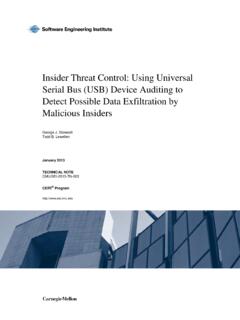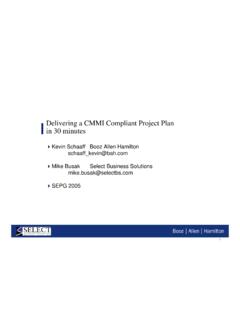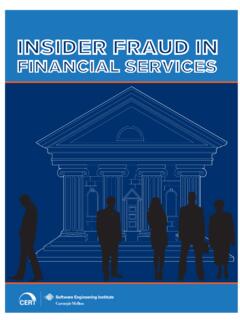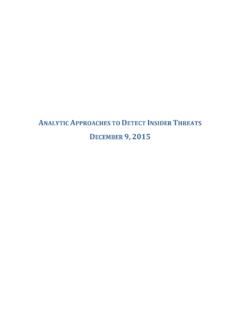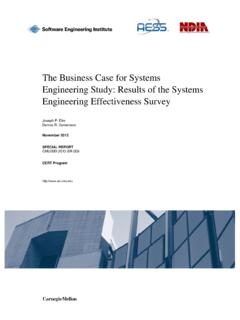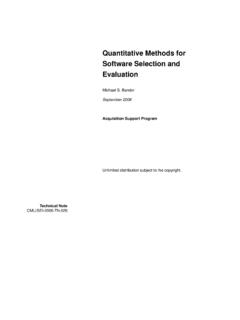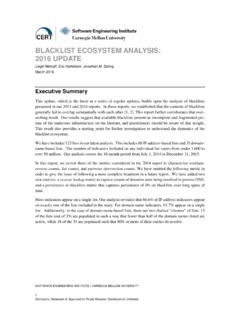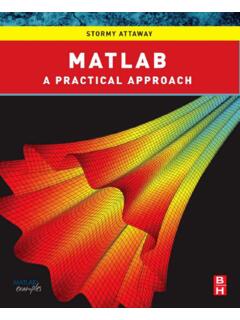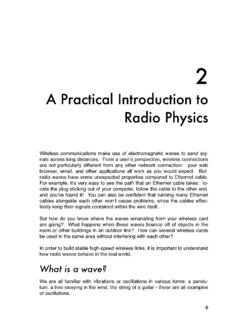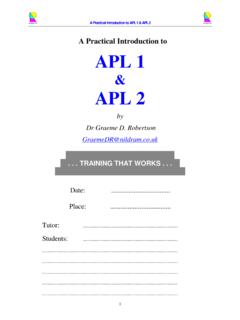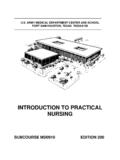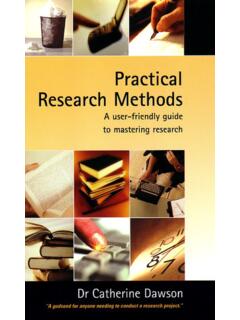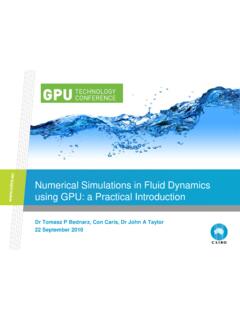Transcription of Product Line Analysis: A Practical Introduction
1 TECHNICAL REPORT CMU/SEI-2001-TR-001 ESC-TR-2001-001 Product line analysis : A Practical Introduction Gary Chastek Patrick Donohoe Kyo Chul Kang (Pohang University of Science and Technology) Steffen Thiel (Robert Bosch GmbH) June 2001 Pittsburgh, PA 15213-3890 Product line analysis : A Practical Introduction CMU/SEI-2001-TR-001 ESC-TR-2001-001 Gary Chastek Patrick Donohoe Kyo Chul Kang (Pohang University of Science and Technology) Steffen Thiel (Robert Bosch GmbH) June 2001 Product line Systems Program Unlimited distribution subject to the copyright. Last printed 9/27/01 7:47 AM / version / bw4le This report was prepared for the SEI Joint Program Office HQ ESC/DIB 5 Eglin Street Hanscom AFB, MA 01731-2116 The ideas and findings in this report should not be construed as an official DoD position. It is published in the interest of scientific and technical information exchange.
2 FOR THE COMMANDER Norton L. Compton, Lt Col., USAF SEI Joint Program Office This work is sponsored by the Department of Defense. The Software Engineering Institute is a federally funded research and development center sponsored by the Department of Defense. Copyright 2001 by Carnegie Mellon University. NO WARRANTY THIS CARNEGIE MELLON UNIVERSITY AND SOFTWARE ENGINEERING INSTITUTE MATERIAL IS FURNISHED ON AN "AS-IS" BASIS. CARNEGIE MELLON UNIVERSITY MAKES NO WARRANTIES OF ANY KIND, EITHER EXPRESSED OR IMPLIED, AS TO ANY MATTER INCLUDING, BUT NOT LIMITED TO, WARRANTY OF FITNESS FOR PURPOSE OR MERCHANTABILITY, EXCLUSIVITY, OR RESULTS OBTAINED FROM USE OF THE MATERIAL. CARNEGIE MELLON UNIVERSITY DOES NOT MAKE ANY WARRANTY OF ANY KIND WITH RESPECT TO FREEDOM FROM PATENT, TRADEMARK, OR COPYRIGHT INFRINGEMENT. Use of any trademarks in this report is not intended in any way to infringe on the rights of the trademark holder.
3 Internal use. Permission to reproduce this document and to prepare derivative works from this document for internal use is granted, provided the copyright and "No Warranty" statements are included with all reproductions and derivative works. External use. Requests for permission to reproduce this document or prepare derivative works of this document for external and commercial use should be addressed to the SEI Licensing Agent. This work was created in the performance of Federal Government Contract Number F19628-00-C-0003 with Carnegie Mellon University for the operation of the Software Engineering Institute, a federally funded research and development center. The Government of the United States has a royalty-free government-purpose license to use, duplicate, or disclose the work, in whole or in part and in any manner, and to have or permit others to do so, for government purposes pursuant to the copyright license under the clause at For information about purchasing paper copies of SEI reports, please visit the publications portion of our Web site ( ).
4 CMU/SEI-2001-TR-001 i Table of Contents Abstract vii 1 Introduction 1 The Context of Product line analysis 2 About This Report 3 2 Product line Requirements 5 Sources of Product line Requirements 6 Product line Stakeholders 6 Product line Practice Areas 8 Users of Product line Requirements 10 From Requirements to Architecture 10 Introduction to the Example: Home Integration System (HIS) 11 Business Context 11 The Econo-HIS Product 12 The Lux-HIS Product 12 Summary 13 3 The Requirements Model 15 The Use-Case Model 15 The Object Model 17 The Feature Model 19 The Dictionary 21 Work Product Relationships 21 Summary 24 4 Requirements Modeling 25 Recursive Refinement 25 ii CMU/SEI-2001-TR-001 analysis 28 Commonality and Variability analysis 28 Consistency analysis 30 Feature Interaction analysis 30 Model Quality analysis 31 Requirements Priority analysis 31 Verification 32 Summary 33 5 Modeling Strategies
5 35 A Feature-Driven Strategy 36 Strategy Context 36 Feature Modeling 37 Use-Case Modeling 38 Object Modeling 38 A Use-Case-Driven Strategy 39 Strategy Context 39 Use-Case Modeling 40 Feature Modeling 40 Object Modeling 41 Summary 41 6 Conclusions and Future Work 43 Robustness 43 Extensions 44 References 47 Appendix A: Example Stakeholder Checklist 51 Appendix B: Work Product Interactions 53 CMU/SEI-2001-TR-001 iii List of Figures Figure 1: Product line Requirements: Coverage 5 Figure 2: Stakeholder Views 7 Figure 3: Practice Areas: Initial Requirements Information Sources 9 Figure 4: Stakeholder Hierarchy 16 Figure 5: Requirements Objects and Information Exchanges 19 Figure 6: HIS Feature Model Upper Levels 20 Figure 7: Safety Features of HIS 20 Figure 8: Relationships Among Use Cases, Objects, and Features 22 Figure 9: Work Product Relationships 22 Figure 10: Model Relationships Under the Feature-Driven Strategy 37 Figure 11: Model Relationships Under the Use-Case-Driven Strategy 40 iv CMU/SEI-2001-TR-001 CMU/SEI-2001-TR-001 v List of Tables Ta b l e 1 : Recursive Refinement of the Requirements Model 26 Ta b l e 2 : Example Checklist of Product line Stakeholders 51 vi CMU/SEI-2001-TR-001 CMU/SEI-2001-TR-001 vii Abstract Product line analysis applies established modeling techniques to engineer the requirements for a Product line of software-intensive systems.
6 This report provides practitioners with a Practical Introduction to Product line requirements modeling. It describes Product line analy-sis in the context of Product line development. The report also shows how a requirements model is built from work products that are based on object modeling, use-case modeling, and feature-modeling techniques. A running example, based on home automation systems, illus-trates concepts and terminology. Two different strategies for creating the requirements model are also presented. The Product line analysis work is evolving. This report describes its current status and planned development. viii CMU/SEI-2001-TR-001 CMU/SEI-2001-TR-001 1 1 Introduction Product line analysis is requirements engineering for a Product line of software-intensive sys-tems.
7 It encompasses the elicitation, analysis , specification, and verification1 of the require-ments for a Product line . It is the requirements analyst s perspective of the role of require-ments engineering in a Product line development. Requirements are statements of what a system must do, how it must behave, the properties it must exhibit, the qualities it must possess, and the constraints that the system and its devel-opment must satisfy. The Institute of Electrical and Electronic Engineers (IEEE) defines a requirement as 1. a condition or capability needed by a user to solve a problem or achieve an objective 2. a condition or capability that must be met or possessed by a system or system compo-nent to satisfy a contract, standard, specification, or other formally imposed document 3. a documented representation of a condition or capability as in (1) or (2) [IEEE 90] Product line analysis specifies requirements for a Product line in a model rather than a natu-ral-language document [B ckle 00, Jacobson 97].
8 Its primary goal is identifying and analyz-ing opportunities for large-grained reuse within the requirements. To achieve this, it creates a requirements model that identifies common requirements across the Product line and the ac-ceptable variations of those requirements. The model has two important characteristics: 1. It specifies the functionality and quality attributes (such as performance or modifiability) of the products in the Product line . 2. Its structure reflects decisions about common and variant capabilities and behaviors across the Product line . The requirements model also serves as a fundamental communications mechanism between developers and other stakeholders of a Product 1 For brevity, in this report the term verification also includes validation, except in cases where the specific activities of one or the other are discussed.
9 2 CMU/SEI-2001-TR-001 The Context of Product line analysis Product line analysis is part of Product line The decision to develop and man-age a Product line begins with identifying a business opportunity that, potentially, can be real-ized by exploiting strategic reuse; that is, creating sets of related products from common parts. Product line development spans the path from the initial recognition of such a business opportunity to the creation of the actual products. The products result from business and en-gineering decisions that determine what products to offer, how they should be built, and how they should evolve over the life of the Product line .
10 These decisions center on an organiza-tion s ability to develop assets that can be reused in multiple products. Furthermore, decisions about the evolution of a single Product are made within the broader context of the evolution of the Product line . Clements and Northrop define a software Product line as follows [Clements 01]: A software Product line is a set of software-intensive systems sharing a common, managed set of features that satisfy the specific needs of a particular market or mission and that are developed from a common set of core assets in a prescribed way. The requirements for a Product line cover not only products and their features, but also in-formation to support business and technical decisions. This report focuses on Product line analysis as it applies to asset development, in particular the assets created by the Product line architect (for reasons discussed in Section 2).

